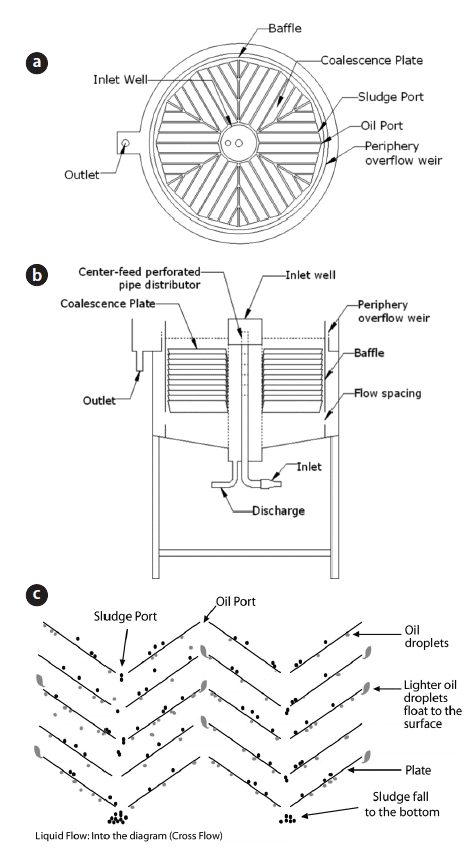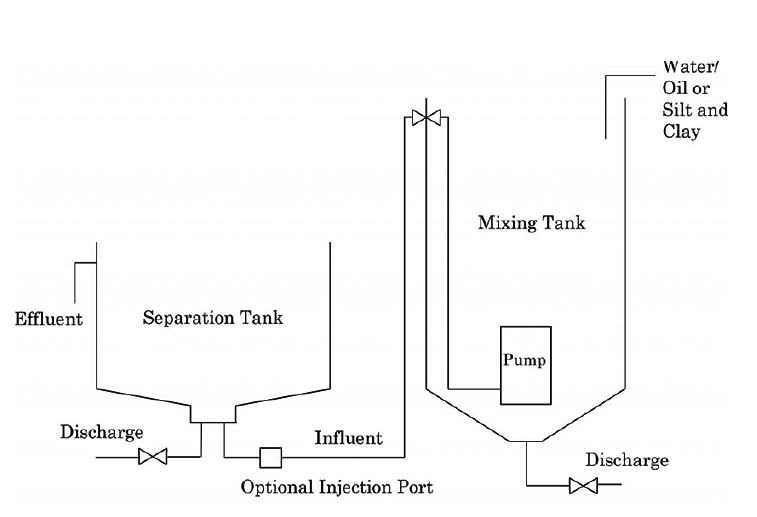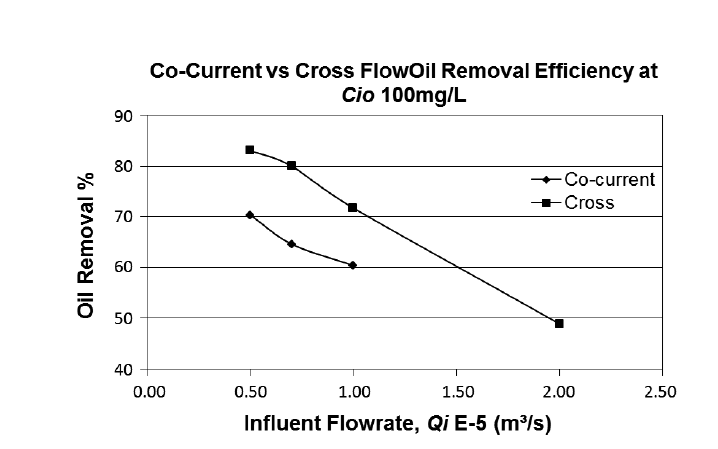Effects of Co-current and Cross Flows on Circular Enhanced Gravity Plate Separator Efficiencies
Article information
Abstract
This study compares the effects of flow on oil and suspended solids removal efficiencies in circular enhanced gravity plate separator equipped with coalescence medium. Coalescence medium acts to capture rising oil droplets and settling solid particles and assist in the coalescence of oil and coagulation of solid. The circular separator uses an upflow center-feed perforated-pipe distributor as the inlet. The co-current flow is achieved using 4 increasing sizes of frustum, whereas cross flow uses inclined coalescence plates running along the radius of the separator. The different arrangement gave the cross flow separator a higher coalescence plan area per operational volume, minimal and constant travelling distance for the oil droplets and particles, lower retention time, and higher operational. The cross flow separator exhibited 6.04% and 13.16% higher oil and total suspended solids removal efficiencies as compared to co-current flow.
1. Introduction
Regulatory requirement for oil and suspended solids content allowable in sewage and industrial effluent discharge are ≤10 mg/L and ≤100 mg/L, respectively, for most countries, such as the United State, Canada, Colombia, Malaysia, and some European countries [1]. Effluent from oil and gas industry or shipping activities contains high amount of oil [2]. Wastewater high with suspended solids particles due to erosion are introduced into the environment from land clearing and earthworks activities [3].
Most separators used to treat oil or solids are rectangular separator [4]. Some of these separators currently in use include 1) the American Petroleum Institute separators, 2) coalescing plate separators, 3) coalescing tube separators, and 4) packing type separators [5]. Rectangular separator has a constant horizontal velocity, vh throughout. In rectangular separator, co-current flow is favorable for solid particles removal whereas cross flow is preferable for oil separation [6].
A circular separator takes advantage of the continual decrease in horizontal velocity, vh as surface area increases along the radius. The decrease in horizontal velocity, vh enhances separation. The circular separator is more compact as compare to rectangular separator [7]. The aim of this study is to determine which flow pattern along coalescence medium is preferable for oil and solid separation in a circular separator.
Coalescence mediums in the form of parallel plates are applied in enhanced gravity separators to increase the separation efficiency by making the settling distance smaller and the interfacial area for the coalescence larger. In these separators, the oil droplets rise to the upper plate and form a trickling film which flows along the plate following the hydrostatic pressure gradient to the principal interface as shown in Fig. 1 [8–10]. Droplets of oil then coalesce on the trickling film [9].
Circular oil-water-solid separator with coalescing plates are suitable for applications on small-scale wastewater flow for workshop, oil terminal, land clearing and earthwork surface runoff, residential at rural or low population density areas where the transportation of wastewater to a central treatment system is costly [11]. This separator is also suitable for wastewater treatment where availability of large area is a constraint, such as on oil and gas platforms and shipping activities.
2. Materials and Methods
Co-current and cross flow were achieved in circular separator by utilizing an upflow center-feed perforated-pipe distributor as the inlet [12] directing flow to different arrangement of inclined coalescence plates. Fig. 2(a) illustrates how inclined plates were arranged to achieved co-current flow. The arrangement consists of four series of inclined frustums. Each series consists of several successive layers of frustums. The frustums were inclined at an angle of 55° (up-right) [13] and 125° (inverted) that subsequently form a multiple-angle arrangement. All frustums had an inclined length of 10.0 cm. The amount of frustums increases with each subsequent series, and the interval between frustum decreases with each subsequent series [7]. Fig. 2(b) shows the mechanism of oil-water-solid separation for co-current flow.
Fig. 3(a) and (b) illustrates the arrangement of plates to achieve cross flow. The arrangement consists of 6 set of coalescing plates, each covering 60° of the circular separation tank. Each coalescing plates set consists of several parallel successive layer of plates inclined at angle θ, 55° and 125° to form the dual angle coalescing plates arrangement. The intervals between inclined plates are constant, and the intervals between stacks of inclined plates form the oil and sludge port [11]. Fig. 3(c) shows the mechanism of oil-water-solid separation for cross flow.

Cross flow (a) plate arrangement (top view), (b) plate arrangement (cross sectional view), and (c) oil-water-solid separation mechanism.
2.1. Oil-Water-Solid Separation Mechanism
Coalescence plates promote laminar flow and facilitate the coalescence of oil droplets and the coagulation of solid particles. Plates are kept at a minimal spacing to reduce the vertical distance that the oil droplets and solids particles need to travel before encountering a plate. Droplets and particles captured on the plates would increase in size. When they are large enough the buoyancy forces will overcome the attractive forces holding the droplets and particles to the plate [14]. Then the large droplets rose to the surface to be skimmed out and the coagulated particles settled to the bottom.
In rectangular separator the plates extend from one side of the separator all the way to the opposite side of the separator; all captured oil/solids must progress along the entire length of the plate before exiting to the surface at the opposite side of the separator [15]. In a large separator, this could measure 2.5 m in length, or more. This means that the amount of oil running along the undersides of plates increases as it moves upward along the sloped surface of the plates.
In circular separator, oil/sludge ports are placed at intervals along the radius (co-current) or vertically aligned along the radius (cross flow) for the quick release of oil droplets and solid particles from the plates to rise to the surface or fall to the bottom of the tank. These are illustrated in Figs. 2(b) and 3(c).
2.2. Different between Co-current and Cross Flow Circular Separator
Both the separators were designed with 86 L of operational volume [16]. The coalescence plate arrangements for cross flow separator gave a higher coalescing plan area per operational volume of 0.0436 m2/L as compared to co-current flow with 0.0241 m2/L [17]. Higher coalescing plan area provides more surface area for oil droplets to coalesce and solids particles to coagulate, hence theoretically enable higher removal capacities of oil droplets and solid particles. Due to this, separator with cross flow can operate at higher operational flowrates which allow more waste water to be treated.
2.3. Experimental Procedure
Influent oil water mixtures were prepared from used palm olein oil with mass density (ρo) of 917 kg/m3. Different influent oil concentrations, Cio were prepared (50, 75, 100, 150, 200, and 250 mg/L). Oil concentrations in water were measured using an oil-in-water analyzer which is a non-dispersive infrared absorption method. The measurement error for this instrument is ±0.2 mg/L (oil content analyser OCMA-310; Horiba, Tokyo, Japan).
Influent suspended solids water mixtures were prepared from sieved silt and clay particles that passed through 0.063 mm sieve (with specific gravity of 2.72) [18]. Seven different influent suspended solids concentrations, Ciss, were prepared: 100, 150, 200, 250, 300, 350, and 400 mg/L. Total suspended solids (TSS) were measured by a spectrophotometer (DR/2400; HACH, Loveland, CO, USA) using the photometric method at 810 nm. The instrument wavelength accuracy is ±1 nm and calibrated automatically via internal filter.
The prepared influent mixtures were tested at four different influent flowrates (Qi; 0.5 × 10−5, 0.7 × 10−5, 1.0 × 10−5, and 2.0 × 10−5 m3/s). Fig. 4 indicates the schematic diagram of the experimental setup.
3. Results and Discussions
3.1. Oil Removal
Fig. 5 illustrates the average oil removal efficiencies, Eo of various Cio at different Qi of the cross flow separator. The average Eo of various Cio increases with decreases in Qi. The average Eo at Qi of 0.5 × 10−5, 0.7 × 10−5, 1.0 × 10−5, and 2.0 × 10−5 m3/s were 83.8%, 78.4%, 72.4%, and 64.3%, respectively. The R2 correlation of Qi relation with average Eo was 0.9965. The equation Eo = 73.065 (Qi × 10−5)−0.193 can be used to determine the average oil removal efficiency of cross flow at given Qi.
Fig. 6 compares the oil removal efficiencies of co-current flow and cross flow for circular separator at Cio of 100 mg/L [11]. It indicates that oil removal for cross flow is approximately 13.16% higher compared to co-current flow.
3.2. Suspended Solids Removal
Fig. 7 shows the relationship of average TSS removal efficiencies, Ess of various Ciss at different Qi for the co-current flow and cross flow separators. Similar to oil removal trend, it was also observed that average Ess of various Ciss increases when Qi decreases. For cross flow separator the average Ess at Qi of 0.5 × 10−5, 0.7 × 10−5, 1.0 × 10−5, and 2.0 × 10−5 m3/s were 67.1%, 62.6%, 56.7%, and 46.9%, respectively. The R2 correlation of Qi relation with average Ess was 0.9973. The equation Ess = 56.472 (Qi × 10−5)−0.262 can be used to determine the average TSS removal efficiency of the cross flow separator at given Qi.

Average total suspended solid removal efficiencies, Ess of various Ciss at different Qi for (a) co-current flow separator and (b) cross flow separator. TSS: total suspended solids.
For co-current flow separator the average Ess at Qi of 0.5 × 10−5, 0.7 × 10−5, 1.0 × 10−5, and 2.0 × 10−5 m3/s were 60.70%, 54.91%, 50.06%, and 43.45%, respectively. The R2 correlation of Qi relation with average Ess was 0.9916. The equation Ess = 50.799 (Qi × 10−5)−0.238 represents the relationship between average TSS removal efficiency of the co-current flow separator with Qi.
Comparatively, cross flow has an average 6.04% higher TSS removal rate as compared to co-current flow. It is approximately 12 % higher at lower influent concentration of 100 and 150 mg/L.
3.3. Discussion
Circular plate separator with cross flow exhibits 6.04% and 13.16% higher oil and TSS removal efficiencies as compared to co-current flow. Cross flow coalescence medium arrangement return a higher coalescing plan area per operational volume of 0.0436 m2/L as compared to co-current flow with 0.0241 m2/L. This gave cross flow more surface area for oil droplets to coalesce and solids particles to coagulate, and hence increases its removal capacity.
The arrangement of coalescence plates with relation to the flow direction gave cross flow a constant distance (denoted as x in Fig. 8) for oil droplets/solid particles to travel before it meet a coalescence plate. With a co-current flow arrangement the distance might varies from x to y depending on the size of the droplets/particles. Therefore, in cross flow arrangement, oil droplets/solid particles regardless of its size need only to travel the minimum x distance before it encounter a coalescence plate. These factors enhance separation and performance in the cross flow separator. With a cross flow arrangement a separator can be operated at higher flowrate and shorter retention time to achieve comparable results with a co-current flow separator.
4. Conclusions
Circular enhanced gravity plate separator with cross flow exhibits 6.04% and 13.16% higher oil and TSS removal efficiencies as compared to co-current flow. Cross flow coalescence medium arrangement has a better removal performances due to its higher coalescing plan area per operational volume and minimum and constant droplets/particles travelling distance between coalescence plates.
Acknowledgments
The authors wish to thank the Malaysian Ministry of Science, Technology and Innovation which funded the research work related to this paper.






